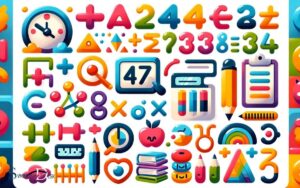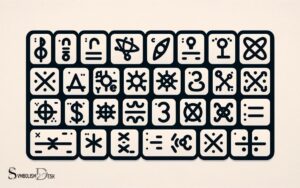What Do the Powerschool Symbols Mean? Parents!
PowerSchool is an educational software that helps students, teachers, parents, and administrators to keep track of students’ progress, attendance, grades, and assignments.
The platform uses specific symbols to represent various elements within the system. To fully understand and use PowerSchool effectively, it’s essential to know what these symbols mean.
PowerSchool symbols serve as visual indicators to provide quick and easy-to-understand information about students’ progress and performance. These symbols play a crucial role in helping all users navigate and interpret the data within the system.
PowerSchool symbols are essential for effective communication within the platform. They provide a clear and concise way of representing complex information, allowing users to quickly grasp the status of assignments, grades, and attendance.
By understanding these symbols, students can stay on track with their academic progress, parents can monitor their child’s performance, and teachers can easily identify areas where students may need additional support or intervention.
12 Explanation of PowerSchool Symbols
| Symbol | Description |
|---|---|
| P | Present |
| A | Absent |
| T | Tardy |
| EX | Excused |
| M | Missing |
| I | Incomplete |
| NG | No Grade |
| W | Withdrawn |
| S | Satisfactory |
| U | Unsatisfactory |
| CR | Credit Earned |
| NCR | No Credit Earned |
Key Takeaway

Five Facts About: PowerSchool Symbols
Deciphering The Powerschool Grading Symbols
When it comes to tracking academic progress, powerschool is an efficient and convenient grading tool that teachers and parents rely on.
However, deciphering the powerschool grading symbols can be overwhelming if you’re not familiar with them.
In this section, we will be discussing what the different grade symbols represent, how letter grades are represented, and what the numbers and symbols next to the letter grades mean.
What Are The Different Grade Symbols In Powerschool?
Powerschool uses different symbols to signify various grades, points, and progress.
Here are some common ones that you should know:
- Letter grades: A, b, c, d, and f
- Check marks: Indicate that an assignment or task is complete, but no grade has been given yet
- Exclamation marks: Indicate that the teacher has not yet graded an assignment
- Points: Points are used to measure a student’s performance in a given assignment. They are represented with numbers ranging from 1-100.
- Hyphen (-): No grade recorded yet or the assignment has not been scored
- Infinity symbol (∞): This symbol is used when a student has exceeded the maximum number of allowed excused absences, and the grade is automatically set to zero.
How Are Letter Grades Represented In Powerschool?
In powerschool, letter grades are represented with the following symbols:
- A: The student’s performance is exceptional.
- B: The student’s performance is above average.
- C: The student’s performance is average.
- D: The student’s performance is below average.
- F: The student has failed, and no credit is given for the course.
Each letter grade corresponds to a numerical value that is used to calculate a student’s gpa (grade point average).
What Do The Numbers And Symbols Next To The Letter Grades Mean?
The numbers and symbols next to the letter grades in powerschool indicate the following:
- %: The percentage of points earned.
- /: The percentage of assignments completed.
- : Indicates that the assignment is an extra credit assignment.
- ^: Indicates that the assignment has been dropped from the final grade calculation.
- #: The number of times an assignment has been entered into the grade book.
Understanding the different powerschool grading symbols is essential for tracking a student’s academic progress.
Keep in mind that letter grades correspond to numerical values that are used to calculate a student’s gpa.
Moreover, numbers and symbols next to letter grades indicate different aspects of a student’s performance, like percentage of assignments completed and extra credit assignments.
By keeping these factors in mind, students, parents, and teachers can utilize powerschool more efficiently.
Understanding Attendance Symbols
Attendance tracking is a vital part of student learning in schools, ensuring that they are present and engaged during lessons.
Powerschool, a popular student management system, provides an intuitive interface that helps educators and parents alike to keep track of attendance quickly and efficiently.
This post provides a comprehensive guide to understanding attendance symbols in powerschool.
Types Of Attendance Symbols Found In Powerschool
Powerschool has several attendance symbols, each indicating different circumstances surrounding the student’s absence or presence.
Below are the different attendance codes that one may encounter and their meanings:
- Ac: The student is marked absent due to an unexcused absence.
- Ad: The student is marked absent due to a disciplinary action.
- Au: The student is marked absent, but will make up the work for the class.
- Ex: The student is marked absent due to an extracurricular activity.
- Fu: The student is marked absent, and the absence is due to a family emergency.
- Ha: The student is marked absent, and another teacher has marked them present, creating a conflict in the system.
- Hl: The student is marked absent due to a school-sponsored activity or field trip.
- Il: The student is marked absent, and the reason is unknown.
- La: The student is marked late and is joining the class after the start time.
- Pa: The student is marked present.
- Pe: The student is marked absent, and the reason is a personal matter.
- Un: The teacher has not marked the attendance yet.
What Do The Different Attendance Codes Signify?
The various attendance codes in powerschool convey a unique significance and reason for the student’s presence or absence.
Some codes denote an excusable absence, while others indicate disciplinary action or other school-sponsored activities.
Understanding what each attendance code signifies is essential when analyzing the overall attendance record of the student.
How To Interpret Attendance Data In Powerschool
Analyzing attendance data in powerschool can provide valuable insight into the academic performance and engagement of the student.
Here are a few tips to help you interpret the attendance data:
- Check the attendance record frequently and analyze it regularly to spot patterns or underlying causes of absences.
- Review the attendance data in conjunction with other academic data to help identify trends in the student’s academic progress.
- Request additional information from the school or student if there are frequent, unexplained absences on the attendance record.
- Monitor the student’s attendance against state-mandated attendance requirements, ensuring that they meet the required minimum.
Understanding attendance symbols in powerschool is a crucial aspect of ensuring the academic success of students.
Analyzing attendance data allows educators and parents to identify areas of concern that require further attention, so it is essential to understand what each attendance code conveys.
By following these tips, you can interpret the data more effectively and, in turn, lead to better-informed decisions about a student’s academic progress and engagement.
The Meaning Behind Behavior Codes
When it comes to student behavior, understanding behavior codes in powerschool is crucial.
The behavioral codes can provide information on student habits, performance, and actions, helping teachers and parents identify issues early, so they can be addressed promptly.
What Are The Different Behavior Codes In Powerschool?
Powerschool offers a range of behavior codes for teachers and administrators to use. These codes range from excellent to unacceptable, allowing for precise classification of student performance.
Some of the codes include:
- E: Excellent
- S: Satisfactory
- M: Needs improvement
- N: Unsatisfactory
- U: Unacceptable
How Are Behavior Codes Used To Track Student Behavior?
Behavior codes are essential tools for tracking a student’s academic progress. These codes can be used to highlight areas that require improvement, such as conduct, effort, and attendance.
Teachers and administrators can make use of these codes to help identify and deal with academic struggles and behavioral issues.
This process has proven to help students stay on the right track and achieve academic success.
Strategies For Interpreting And Managing Behavior Codes In Powerschool
Interpreting and managing powerschool behavior codes requires a proactive response from teachers, administrators, and parents.
Below are some effective strategies for managing behavior codes:
- Review and monitor: Consistent monitoring and review of the behavior codes can provide insights into student progress or specific areas that need improvement.
- Early intervention: Address behavior codes before they escalate, through early intervention, communication, and support.
- Foster transparency: Encourage transparency among teachers, administrators, and parents to ensure everyone is aware of the student’s academic progress.
- Communication: Regular communication between parents, teachers, and students is essential to build a strong academic network.
- Positive reinforcement: Encouraging improvement through constructive feedback and positive reinforcement can help students develop and learn.
Understanding behavior codes in powerschool is critical for efficient and effective student management. With the right strategies in place, teachers, administrators, and parents can work together to help students achieve their potential.
What Does the Pause Symbol Mean in Powerschool?
The video playback symbol meaning in Powerschool’s pause button indicates a temporary stop or break in the playback of a video. It allows users to halt the video at a specific moment without ending the entire playback. The pause symbol is recognizable as two vertical parallel bars and is commonly used across various media platforms.
FAQ About What Do The Powerschool Symbols Mean
What Do The Powerschool Symbols Mean?
Powerschool symbols indicate various educational outcomes, like assignment status, attendance, and grades.
How Do I Access Powerschool Symbols?
You can access the powerschool symbols through the student or parent portal using your login credentials.
What Does The Double Asterisk Symbol Mean?
The double asterisks (**) symbol highlights a grade that has been changed from the original input by a teacher or administrator.
What Is The Meaning Of The Letter “I” In Powerschool?
Letter “i” in powerschool stands for “incomplete”. It indicates a missing or incomplete assignment.
How Often Are Powerschool Symbols Updated?
Powerschool symbols are updated in real-time, which means they are available to students and parents as soon as they are recorded.
Conclusion
Understanding the symbols in powerschool is crucial for students and parents to keep track of academic progress. With this knowledge, you can easily monitor grades, absences, assignments, and teacher comments.
The “pencil” symbol represents a teacher’s comment on a student’s assignment, while a yellow “!” Highlights that the assignment requires attention. The “checkmark” icon signifies that the assignment has been successfully completed and reviewed. Similarly, a red “X” indicates that the submission did not meet the required criteria and may need revision. With these symbols, the platform streamlines communication between teachers and students—it’s almost like seeing the bat symbol meaning explained, signaling action and clarity in a simple, visual way.
The “checkmark” shows a completed assignment, and the percentage next to it indicates the grade received.
Additionally, the “thumbs-up” notification indicates a positive comment from the teacher.
Knowledge of these symbols empowers students and parents to actively participate in the learning process, track progress, and provide support where necessary.
Students can stay on top of their grades and make informed decisions about their academic performance, ultimately leading to greater success in their academic careers.
By utilizing powerschool effectively, you can ensure that your educational journey is smooth and successful.






